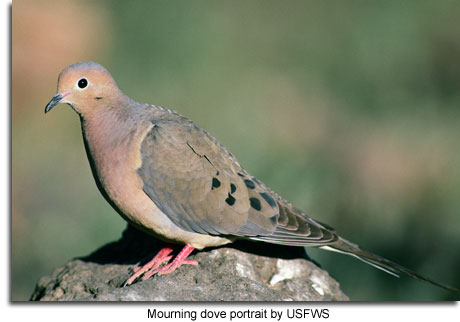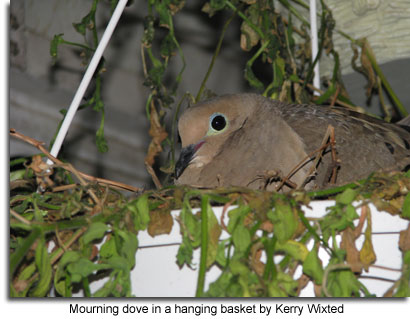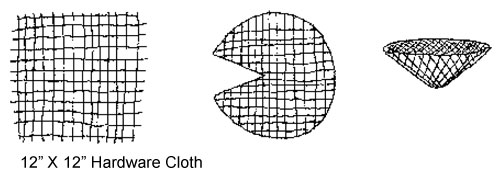Traditionally a farm bird, the mourning dove has adapted to urban and suburban areas. They are one of the most abundant and widely distributed birds in North America with an estimated population size of 350 million birds! The mourning dove is also the most widespread and abundant game bird in North America. Every year hunters harvest more than 20 million.

Natural History
Mourning doves can be identified by their plump, grayish brown body, small head and long pointed tail. These native doves can reach speeds of 37-55 miles per hour while flying. Males can be easily distinguished from females by an iridescent blue patch of feathers on the back of their head and a rosy breast, making them slightly more colorful than the female. They are named for their hollow, sorrowful sounding call, "cooo, cooo, cooo" which is often mistaken for the hoot of an owl. Mourning doves are abundant in Maryland due their ability to adapt to a variety of habitats and to their high reproductive rate. Although mourning doves only lay and rear two eggs at a time, it is not unusual for a pair to have four to six clutches a year. Both the male and female work together to raise the young. Doves make good parents and may even fake an injury to attract predators toward them and away from the nest.
It is estimated that almost 400,000 mourning doves live in Maryland between March and November. In August, a greater number of mourning doves can be seen as some from northern areas pass through Maryland in route to the Carolinas.
Mourning doves prefer to feed on flat surfaces on the ground. They are common visitors to bird feeders which are fond of all sorts of bird seed, especially millet, oat, wheat and cracked corn. Many times, you will see doves foraging on seeds spilled below feeders. Mourning doves consume an average of 12-20 percent of their body weight per day in seeds! Like most other seed eating birds, doves prefer millet and sunflower seed. Since many commercial feeds contain sorghum, wheat, hulled oats and rice along with millet and sunflower seeds, much of premixed bird seed is wasted. Therefore, it may be more economical to just buy the seed they prefer, not the premixed seed.

While mourning doves are common feeder birds, there are several ways in which you can entice more to your backyard. For one, you can plant sunflowers in your yard. In addition, you can also plant tall shrubs and evergreens near feeding sites to provide roosting and nesting areas. Mourning doves will also frequent bird baths, and really enjoy dead trees for roosting. So if you can safely leave a dead tree or snag on your property, then mourning doves may find it and use it.
Doves do not nest in tree cavities or nest boxes. Mourning doves prefer to nest on horizontal branches of pine and cedar trees, but they will also nest in shrubs and even on the ground. Doves typically nest in trees along the edges of fields, pastures, or clearings and are seldom found in densely wooded areas. To create nesting cover for mourning doves, you can plant small clumps of two to three trees or even several single coniferous trees around open fields or your front yard.

Mourning dove nests usually consist of sticks placed in the crotch of a tree. Since these nests are very flimsy, they sometimes will use a hanging baskets or man-made nesting cones made out of hardware cloth to support their nests. Nesting cones are easy to assemble and are an excellent way to attract these interesting birds.
How to Build a Mourning Dove Nesting Cone
Materials:
- 12" x 12" piece of ¼" or ½"mesh hardware cloth
- Wire cutters
- Staples
Construction:
- Cut the edges of the 12” x 12” square hardware cloth to form a circle.
- Cut out a 2 ½" wedge along the outer edge of the circle.
- Pull the two cut edges together to form a cone. Overlap the edges about 1 inch and staple the two edges together.
- The nesting cone should be placed in a partially shaded area, in the crotch of a tree, about 6 to 16 feet above the ground.
- Attach the nest to the tree with nails or staples, bending back the sharp, cut edges of the cloth underneath the cone.

Tips for Attracting Mourning Doves
- Make sure that the cone has enough vegetation around it to conceal the nest, yet not so much that the dove has difficulty accessing the nest.
- Mourning doves like flat, platform-like bird feeders filled with cracked corn, millet, sunflower seeds, and peanut kernels.
- On large properties, planting corn, wheat, or buckwheat will attract mourning doves. Fallow fields with ragweed, crab grass, and pokeweed also attract them. When planting crops for mourning doves, plant in strips near shrubs, which will serve as protection when the doves are frightened. Leave some open ground, as well, to allow the doves to forage for fallen seeds.
Invite Wildlife to Your Backyard!
For more information, please contact:
Maryland Department of Natural Resources
Wildlife and Heritage Service
Tawes State Office Building, E-1
Annapolis MD 21401
410-260-8540
Toll-free in Maryland: 1-877-620-8DNR
[email protected]
Acknowledgements:
- Mourning dove portrait by USFWS
- Sunflower, photo by Kerry Wixted
- Mourning dove in a hanging basket, photo by Kerry Wixted